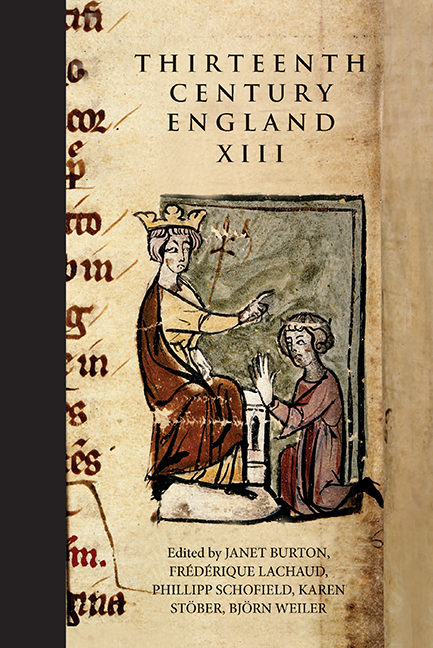Book contents
- Frontmatter
- Contents
- List of Illustrations
- Preface
- Contributors
- Abbreviations
- Political Ideas and Dialogue in England in the Twelfth and Thirteenth Centuries
- Peripatetic and Sedentary Kingship: The Itineraries of John and Henry III
- Peter of Aigueblanche's Support Network
- A Captive King: Henry III between the Battles of Lewes and Evesham, 1264–5
- The Conflictus inter Deum et Diabolum and the Emergence of the Literature of Law in Thirteenth-Century England
- Prosecuting Ravishment in Thirteenth-Century England
- John of Crakehall: The ‘Forgotten’ Baronial Treasurer, 1258–60
- Credit Finance in Thirteenth-Century England: The Ricciardi of Lucca and Edward I, 1272–94
- (Socio)linguistic Realities of Cross-Channel Communication in the Thirteenth Century
- The Treaties of Paris
Peripatetic and Sedentary Kingship: The Itineraries of John and Henry III
Published online by Cambridge University Press: 15 September 2017
- Frontmatter
- Contents
- List of Illustrations
- Preface
- Contributors
- Abbreviations
- Political Ideas and Dialogue in England in the Twelfth and Thirteenth Centuries
- Peripatetic and Sedentary Kingship: The Itineraries of John and Henry III
- Peter of Aigueblanche's Support Network
- A Captive King: Henry III between the Battles of Lewes and Evesham, 1264–5
- The Conflictus inter Deum et Diabolum and the Emergence of the Literature of Law in Thirteenth-Century England
- Prosecuting Ravishment in Thirteenth-Century England
- John of Crakehall: The ‘Forgotten’ Baronial Treasurer, 1258–60
- Credit Finance in Thirteenth-Century England: The Ricciardi of Lucca and Edward I, 1272–94
- (Socio)linguistic Realities of Cross-Channel Communication in the Thirteenth Century
- The Treaties of Paris
Summary
The itineraries of the thirteenth-century English kings have not yet been given the attention they merit. Little in the way of thorough research has been produced beyond the compiling of the actual itineraries themselves. These compiled itineraries are of particular importance as it is only in the thirteenth century that the royal itineraries become complete enough to enable a detailed study to be undertaken. King John is the first English monarch whose travels can be followed on a near daily basis. This paper sets out to examine the itineraries of King John from 1199 to 1216 and of Henry III during both the minority government from 1216 to 1226 and the first phase of his personal rule from 1234 to 1241. The royal itinerary is not only of interest to modern historians – it was of great importance to contemporaries as well. For instance, The History of William Marshal has a plethora of references detailing where John went and when he went there.
There are various types of questions which can be addressed. There are those relating to the nature of the itinerary itself – how fast and how far did the royal household travel, as well as where the king travelled to and how long he remained stationary at each location. There are also those questions concerned with the purpose of the itinerary – why the king travelled. One of the most fundamental questions relating to the itinerary is to what extent there was a capital-based government at Westminster. One of the clearest declarations of the view that there was not – and perhaps the most well known – was made by Jolliffe who wrote ‘it was a government in itinere – not one which went out intermittently and for limited commissions, but one in perpetual movement, a government of the roads and roadsides … England had no capital but the king's highway’. John Le Patourel agreed and expressed just how ingrained this lifestyle was, stating ‘Before 1066 the Norman dukes had not attempted to rule their duchy from a fixed seat of government … After 1066 it is equally clear that the Norman kings continued this life of movement.’ Although Robert Bartlett has gone so far as to state that ‘A sedentary court was not inconceivable … Itineration was not forced on kings and lords, it was chosen by them.’
- Type
- Chapter
- Information
- Thirteenth Century England XIIIProceedings of the Paris Conference, 2009, pp. 11 - 26Publisher: Boydell & BrewerPrint publication year: 2011

